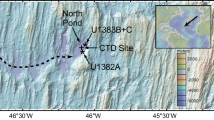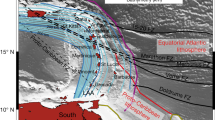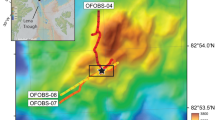Abstract
THERE is abundant evidence that seawater penetrates, and circulates within, the oceanic crust at active spreading centres. Low heat flow values from ridge crests imply that heat must be removed locally by water circulation1–6. Furthermore, hydrous metamorphosed oceanic crust and oceanic serpentines, which required voluminous quantities of water during their formation7–9, also have isotopic compositions which indicate that the isotopic sources had low δ18O values, such as are found in seawater10. The tectonic setting of strike–slip and normal faulting along the rift valley scarps of oceanic ridges is conducive to the penetration of dense, cold water down the fractures, the heating of the water at depth, and the exhalation of the less dense hydrothermal water as submarine springs along fracture systems.
This is a preview of subscription content, access via your institution
Access options
Subscribe to this journal
Receive 51 print issues and online access
$199.00 per year
only $3.90 per issue
Buy this article
- Purchase on Springer Link
- Instant access to full article PDF
Prices may be subject to local taxes which are calculated during checkout
Similar content being viewed by others
References
Anderson, R. N., Bull. geol. Soc. Am., 83, 2947 (1972).
Lister, C. R. B., Geophys. J. R. astr. Soc., 25, 515 (1972).
Deffeyes, K. S., in Megatectonics of Continents and Oceans, 194 (Rutgers University Press, New Brunswick, 1970).
Palmerson, G., in Iceland and Mid-Ocean Ridges (edit. by Bjornsson, S.), 111 (Visindafélag Islendinga, 1967).
Williams, D. L., Von Herzen, R. P., Sclater, J. G., and Anderson, R. N., Geophys. J. R. astr. Soc. (in the press).
Sclater, J. G., Von Herzen, R. P., Williams, D. L., Anderson, R. N., and Klitgord, K. D., Geophys. J. R. astr. Soc. (in the press).
Miyashiro, A., Shido, F., and Ewing, M., Phil. Trans. R. Soc., A 268, 589 (1971).
Miyashiro, A., Shido, F., and Ewing, M., Contr. Miner. Petrol., 23, 38 (1969).
Christensen, N. I., J. Geol., 80, 709 (1972).
Muehlenbachs, K., and Clayton, R. N., Can. J. Earth Sci., 9, 471 (1972).
Scott, R. B., Hajash, A., Kuykendall, W. E., Rona, P. A., Butler, L. W., and Nalwalk, A. J., Trans. Am. geophys. Un., 54, 249 (1973).
Scott, M. R., Scott, R. B., Nalwalk, A. J., Rona, P. A., and Butler, L. W., ibid., 54, 244 (1973).
Ku, T. L., and Glasby, G. P., Geochim. cosmochim. Acta, 36, 699 (1972).
Bertine, K. K., and Turekian, K. K., ibid., 37, 1415 (1973).
McGregor, B. A., Rona, P. A., and Krause, D. C., Trans. Am. geophys. Un., 55, 293 (1974).
Bonatti, E., Kramer, T., and Rydell, H. S., in Ferromanganese Deposits of the Ocean Floor, 149 (Lamont-Doherty of Columbia University, Palisades, 1972).
Scott, R. B., Scott, M. R., Swanson, S. B., Rona, P. A., Butler, L. W., and McGregor, B. A., Trans. Am. geophys Un., 55, 293 (1974).
Rona, P. A., McGregor, B. A., Betzer, P. R., and Krause, D. C., ibid., 55, 293 (1974).
Betzer, P. R., Bolger, G. W., McGregor, B. A., and Rona, P. A., ibid., 55, 293 (1974).
Watkins, N. D., and Paster, T. P., Phil. Trans. R. Soc., A 268, 507 (1971).
Wilson, R. A. M., and Ingham, F. T., Mem. geol. Surv. Dep. Cyprus, 1 (1959).
Robertson, A. H. F., and Hudson, J. D., Earth planet. Sci. Lett., 18, 93 (1973).
Spooner, E. T. C., and Fyfe, W. S., Contr. Miner. Petrol., 42, 287 (1973).
Miyashiro, A., Earth planet. Sci. Lett., 19, 218 (1973).
Strong, D. F., ibid., 21, 301 (1974).
Karig, D. E., J. geophys. Res., 76, 2542 (1971).
Upadhyay, H. D., and Strong, D. F., Econ. Geol., 68, 161 (1973).
Hutchinson, R. W., ibid., 68, 1223 (1973).
Constantinous, G., and Govett, G. T. S., ibid., 68, 843 (1973).
Dmitriev, L. V., Barsukov, V. L., and Udinstev, G. B., Geokhimiya, 4, 93 (1970).
Bonatti, E., Honnorez, J., and Guerstein, M. H., Trans. Am. geophys. Un., 55, 455 (1974).
Meyer, C., and Hemley, J. J., in Geochemistry of Hydrothermal Ore deposits (edit. by Barnes, H. L.), Fig. 6. 9, 220 (Holt Rinehart, Winston, New York, 1967).
Krauskopf, K. B., Geochim. cosmochim. Acta, 12, 61 (1957).
Price, N. H., and Calvert, S. E., Mar. Geol., 9, 145 (1970).
McGregor, B. A., and Rona, P. A., J. geophys. Res. (in the press).
Author information
Authors and Affiliations
Rights and permissions
About this article
Cite this article
SCOTT, R., RONA, P., MCGREGOR, B. et al. The TAG hydrothermal field. Nature 251, 301–302 (1974). https://doi.org/10.1038/251301a0
Received:
Issue Date:
DOI: https://doi.org/10.1038/251301a0
Comments
By submitting a comment you agree to abide by our Terms and Community Guidelines. If you find something abusive or that does not comply with our terms or guidelines please flag it as inappropriate.



